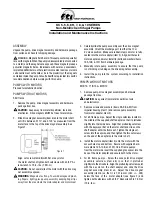
careful if you use the CP2 adapter on some combination
boilers.
Obviously you have to take the boiler case off to fit the
CP2 adapter on to the pump body located within the
boiler casing. If the boiler case is ‘sealed’, i.e. it is part of
the combustion air inlet system, then you do need to be
Gas Safe registered ##.
If the case is only decorative, then you don’t.
## In this case, and you are not Gas Safe registered,
you’d probably connect the Clearflow pump across the
tails of one radiator, after having first removed it.
Q. How do I know how much water is in a system,
particularly larger ones, so that I can add the correct
amount of flushing chemical?
A. It’s always tricky to estimate the amount of water in a
larger system (and no-one ever can tell you from existing
records), and so the industry ‘rule of thumb’ guide is to
multiply the boiler output, expressed in kW, by 12, and
that gives an approximate figure, in litres.
For smaller systems, then assume that 10 radiators (or
radiator panels) is close to 100 litres. More modern
systems frequently contain less water, but it’s always
better to add too much chemical than too little.
Q. Will power flushing cure boiler noises?
A. Boiler noises are often caused by scale or debris
accumulating on heat transfer surfaces, thus preventing
the water from carrying away heat from the metal
surface. This means that the metal runs hotter than
design temperature and may even exceed 100 degrees C.
The layer of scale / debris is never even, and there will
be areas where the water contacts metal above 100
degrees. At this temperature water flashes into steam,
increasing its volume by almost 1500 times. The steam
bubbles then move away from the high temperature
zone and collapse and it is the sound of the implosion
of the steam bubble that you hear. This phenomenon
is most likely to occur when the boiler first fires and is
working hard.
It is a reasonable assumption that if you can remove the
debris / scale (and you usually can when power flushing)
that you will remove the problem.
Having said that, we know that boilers with cast iron
heat exchangers can acquire corrosion pits as they age,
generally if the water treatment has been inadequate. In
these areas, where the heat exchanger metal is reduced
in thickness, the heat flux can be higher than the
designer intended, and there can still be boiler noises no
matter how clean the heat transfer surface may be after
a power flush.
Q. What about double panel radiators - won’t the
water take the course of least resistance and just clear
one panel?
A. Yes, it will. However, whilst carrying out the individual
radiator flush, gently tap the front panel with a rubber
mallet, where the brackets attach to the rear panel.
There will always be at least four points of connection, at
the ends, top and bottom. This vibrates debris loose with
surprisingly good effect.
An even better method
is to use a Radhammer
vibrator device, also
supplied by Kamco. This
device clicks into the
chuck of an SDS drill
which has been set to
‘hammer only’. The high frequency vibration will loosen
debris that will not respond to other cleansing methods.
Q. Is it a good idea to tap radiators whilst carrying out a
power flush?
A. Yes. Many engineers tap every radiator along
the lower edge with a mallet as they open it up for
the individual radiator flush, to vibrate loose any
compacted sludge trapped in the bottom seam. The
Kamco RadHammer is even more effective, and a brief
application of the RadHammer after you have what is
apparently already got clear water running through a
radiator can give surprising results!
Page 4




































